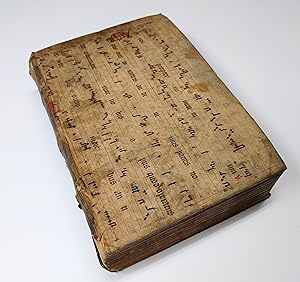A propos de cet article
4to. (XX),702,(1 printers' device),(1 blank) p. Vellum. 25 cm (Ref: stcv: 6633561; Brunet 1,45; Graesse 1,17: 'Édition excellente des anciens parémiographes, avec des notes très utiles'; Ebert 87; Smitskamp, 'The Scaliger Collection', 172) (Details: The vellum the binder used, was once a manuscript leaf with 10 lines black text in Latin from different Psalms, and with black quadratic musical notation on red staves of five lines, for the Gregorian chant. The leaf must have measured ca. 30x40 cm. The neums look rather cursive. The height of the letters is between 0.5 and 0.7 cm; it has 4 capitals surrounded and filled with penwork, they measure ca. 2 cm. The texts seems to contain 4 antiphons, 43/2, 53/26, 39/2-4. The last one is an antiphon, 'Cum sanctificatus fuero in vobis etc.', to be sung on the wednesday (feria iiii) after the 4th sunday in Lent. The letters are too small for a choir. So it is not an antiphonarium leaf. Perhaps it was used for mass. The letter is the gothic 'textura', used for liturgical texts in the 14th & 15th century. It was written probably in Central Europe. This kind of letter was the example for the first printer's typeface. See for the origin of this vellum leaf the provenance below. § Plantin's engraved printer's device on title: 'constantia et labore'; on the last but one page is another bigger version of that printer's mark.) (Condition: Binding soiled. Vellum on the back blackening, cracked and partly damaged, a small piece of vellum at the foot of the back has gone. Front hinge cracking, but strong. The front flyleaf has gone. Old ownership entry in ink on the title. Paper yellowing, some gatherings are browning; 2 leaves of the introduction are loosening) (Note: This title consists of 5 parts, 'Proverbia Zenobii ex Tarrhaeo ac Didymo' (p. 1/168), followed by the 'editio princeps' of 'Diogeniani vulgaria proverbia, graece nunc primum eruta, latine reddita ac scholiis illustrata ab Andreae Schotto' (p. 169/257), then 'Proverbiorum graecorum e Vaticana Bibliotheca Appendix', (p. 258/324), and 'Proverbia ex Suidae collectaneis, Andreae Schotti Societatis Iesu scholiis explicata' (p. 325/579), and finally J.J. Scaliger's 'Stromateus proverbialium versuum', with Schottus' Latin translation and notes (p.581/644). § The first to write about proverbs, in Greek 'paroimiai', was the Greek philosopher Aristotle in his 'Paroimiai'. He considered them remnants of ancient wisdom, early forms of philosophical statements, that were concise and easy to remember. In Alexandrian times proverbs were no longer exclusively subject to philosophical exegesis, and became a literary genre. The Alexandrian philologist Didymus amassed a collection of proverbs in 13 books, from which Lucillus of Tarrha made a compilation of 3 books in the first century A.D. During the reign of the Roman emperor Hadrian the Greek sophist Zenobius excerpted from the collections of Didymus and Lucillus of Tarrha 3 books of proverbs. Ca. 900 a new corpus of proverbs was formed, consisting of an excerpt from the collection of Zenobius, together with a collection ascribed to Plutarchus, and a collection of proverbs that went under the name of the Greek grammarian Diogenianus, who lived in the second century A.D. (N.P. 9,351/52) § The collections of Zenobius and Diogenianus were edited, translated into Latin and annotated by the Dutch Jesuit scholar Andreas Schott, latinized as Andreas Schottus, 1552-1629, who was professor of Latin in Louvain, Toledo and Saragossa. He edited also Aurelius Victor, Pomponius Mela and Seneca Rhetor. His thorough knowledge of Greek is attested by the edition of the 'Bibliotheca' of Photius (1606), and the Chresomathy of Proclus (1615). He was the first to edit the Proverbs of Diogenianus in 1612. Nowadays it is doubted whether Diogenianus really was the author of this Byzantine collection of proverbs. (Sandys 2,305; NP 3, 605/6) Schottus added also proverbs he excerpted from the Suda, a Byzantine encyclopedic lexic.
N° de réf. du vendeur 140043
Contacter le vendeur
Signaler cet article




